I don’t remember any longer when I first heard of Peter van Agtmael, but it was some a little over a decade ago. Since then, I watched the photographer become a member of Magnum, publish his first books, and evolve into one of the United States’ most passionate and adept photographic chroniclers. Politically, much happened in that decade, and with a new book out now — Buzzing at the Sill — I thought this would be a good time to catch up again. The following conversation was conducted over email.
Jörg Colberg: Almost ten years ago, we had a conversation about your work. I’m not necessarily stressing the time to make us both feel old; but for sure a lot of things have happened in between, both for you and of course the country. So maybe let’s stick with your own work first. If you look back to this past decade, how do you see your path (or maybe evolution) as a photographer?
Peter van Agtmael: Ten years. It makes me feel a bit old, and it also feels like yesterday. In many ways I’m working on the same trajectory as when we first spoke. At the time, I was obsessed with the American military and its conduct of the wars in Iraq and Afghanistan. As I spent more time there it opened up massive questions for me about history, the nature of empire, race, class, politics and how to manifest these things through photographs and words. When we last spoke, it was a moment filled with possibility but deep unease. I felt I had a clear calling, but I wasn’t sure I’d even survive working in areas of conflict. Yet somehow I couldn’t logically talk myself out of it, nor did I want to. Those irreconcilable forces made me question the whole nature of free will, though that may be a story for another time. Ten years later, I’ve made a lot of progress with the work, but the end is not nearly in sight. I have four books loosely planned out, which I expect will take me at least fifteen years to finish, and who knows what will arise in the meantime? I’m starting to wonder whether I will be working on this for the rest of my life. I hope so, but the terms have changed somewhat. I’m covering less conflict. Although there are a lot of powerful reasons for covering wars, for me it was also a dark desire, and I’m glad it has mellowed and that I can see the world and my work in broader terms. Still, the need still arises from time to time. Now when I cover conflicts it’s more out of a sense of duty than out of desire. I’m grateful for that.
In terms of the work itself, I’ve spent a lot of time improving my craft. I joined Magnum as a nominee about six months after our first conversation. I barely scraped in, and the dominant feedback I received from the other photographers was that my ideas were good and the work had an appealing rawness, but that I needed to elevate the quality of the individual images. I took that advice very seriously, and began the long process of refining my work while not losing its essence in the process. That’s probably a lifelong task, and one threatened by plenty of pitfalls. By some terms, I’ve made mistakes. I’ve resisted certain tropes that could have led to a more definable but more narrow “style.” I prefer to remain a bit loose on these stylistic questions to better serve the content. After all I’m thinking of each of these books as really just chapters in one vast book. The work will need to remain surprising and revealing over many hundreds of pictures. I think I’m generally on the right path, and I hope things keep improving. Who knows when and why the eye will begin to dull? I hope I have some agency in the process, but I’ve tried to let go of a lot of these kinds of conceits.

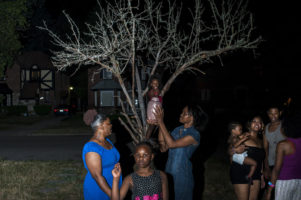
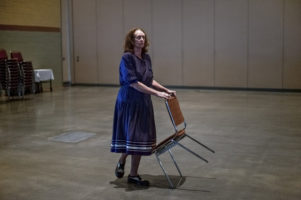
JC: I’ve just got to ask: four books already planned out? It sounds like you have a very clear game plan (if that’s a good word), at least what to go for. Where is this coming from, though? What is feeding this, and how do you adjust to new developments (assuming that’s something that’s needed as you make work)?
PvA: It’s a bit of a strange feeling. It wasn’t planned that way. Back in 2005, I had some vague ideas of what I wanted to do with my work. Over time, through a lot of experiences, from friendships with some remarkable people, and a lot of reading, I began to build a more defined view of America and its place in the world. As my own work developed, I realized I could effectively photograph the imprints of that history in the everyday landscape. That was a tremendously liberating feeling, both in recognizing photographs in places that I previously may have ignored, and realizing that I had found my own path. This has taken many years, and of course my books owe much to tradition, but it’s tremendously satisfying to see the way forward. I’m not trying to be coy about not going into too many specifics. Needless to say, the work to come is both an extension and an expansion of what I’ve done thus far, and deals with America, its history, and its place in the world. Of course those notions are always shifting, so a part of the work is exploring history and another is responding to contemporary events. Although I have core frameworks for each of these works, I’m sure things will shift around over time.
JC: I hope you don’t mind me asking this about the development of your pictures and the efforts you have been making. This is the big struggle, isn’t it? Certainly, as far as I can see, for photographers who go to school, and then, boom!, they’re out in the world, and how do you develop further? Or in your case – how did you go about this? Are you speaking regularly with other photographers about your pictures? I think this might be something a lot of other photographers might be really interested in.
PvA: The first factor has been to shoot relentlessly. I take a camera with me everywhere I go. I’m not always taking pictures, but I try to be mindful in order to keep my eye sharp. Some of my favorite pictures have come at very unexpected moments. I also like to make a comprehensive visual diary at the end of each year, so that forces me to keep shooting. I’m interested in pushing the limits of digital technology. Digital cameras have opened up a lot of possibilities (especially in low light) that weren’t possible with film (or even earlier generations of digital cameras). Testing that still mostly untapped terrain has been a big motivator. I also consume a lot of work, from photojournalism to conceptual work and everything in between. I’m interested in the intersection point between a lot of forms of photography and there’s just so much historical and contemporary work to get through and be inspired by.
I think that being relentlessly self-critical about my work and frequently seeking out the criticism of people whom I trust has been hugely important. It’s a pretty broad group of people… quite a few are Magnum colleagues, but many are not. Christian Hansen has been giving me feedback since the beginning, and my partner, Alia Malek, has a great eye (though she’s a writer). I don’t have much education as a photographer, so I’ve always had to informally seek out critical voices. I think it’s impossible to grow without constantly challenging one’s ideas, work and progress. It’s not always easy. I can be thin-skinned, which is a bit embarrassing. The key thing is to internalize the good advice and have the confidence to understand what advice doesn’t fit the work, as well as sometimes standing firm on certain pictures that other people don’t respond to. It’s not always easy, especially when starting out, but I’ve learned to trust my gut. Of course, sometimes I’m wrong.
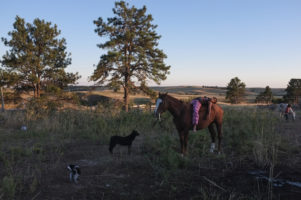
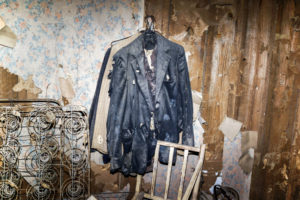
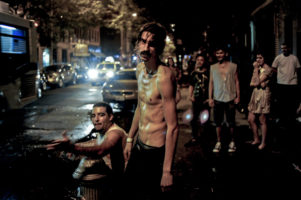
JC: Coming back to you as a photographer and where the work is coming from… Ever since I have known you, you have been driven by a deep sense of wanting to do something about the country, and the things it did, which, of course, focuses initially on photographing its wars, but which has now expanded. I wouldn’t know this, and maybe this is not the case, but I’m guessing that this drive is great because there just is so much more work to do, but it must be also frustrating, given that, for example, after eight years of Obama in the White House, there’s now this huge step back to a new president who talks up torture and bans Muslims from entering the country. How do you deal with all of that? How do you deal with having the kind of limited voice that inevitably we all have, seeing things get better and worse?
PvA: I have a lot of criticisms of the Obama presidency, but it was a clear effort (though only partially successful) to return a sort of stability to domestic and foreign affairs after the upheaval of the Bush administration (I use the term “stability” loosely. The Obama years were anything but calm). Still, these past years allowed for a certain slowdown in my work on strictly contemporary affairs and a shift into how we got to this point. Buzzing at the Sill is the result of that exploration. It’s about the past as much as it’s about the present. The new administration decisively seems to have upheaval in its core ideology, and the fallout from that will inevitably be a big factor in my work. I’m trying not to see the present too narrowly, however, and I have a long list of shoots that I want to accomplish in the coming years that are independent of the news cycle. Of course all these intentions can change in an instant. The future feels especially murky at the moment.
JC: After Trump got elected I argued on my website that the world of photography couldn’t just pretend as if nothing had happened, merely going about its business of selling pictures to rich collectors, while ignoring the larger problems we are all facing now. In some sense, this obviously mostly applies to photographers in the larger sphere of the arts, but it also does apply to others as well. What do you think? Do we have to change things, and if yes, what can we (should we) do?
PvA: I think it’s a powerful time for self-reflection and self-criticism. The arts, the media, Hollywood and the vastness of pop culture all exist in pretty substantial bubbles. These bubbles are often narrow and self-reinforcing, and far from a representative cross section of the culture. Because a lot of these fields slant to the left, it appears that some degree of complacency built up over the past eight years. Now, there is an effort by the administration to dismantle some of the things that many consider the core values of American society. There seems to be a lot of simultaneous efforts to resist that change. The sustainability and cohesiveness of these movements will likely define how successful that resistance is going to be. I remember watching the decline of the anti-Iraq war movement, and it was a painful sight, and a cautionary tale. At this moment, it’s hard to quantify the strength of the opposition to the administrations policies. Despite working in or traveling through all fifty states in the past eight years, I was surprised by Trump’s depth of support. These days, I’m spending a lot of time reevaluating what I thought I knew and trying to educate myself on some of the glaring holes. It’s not an easy process.
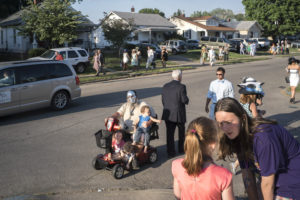
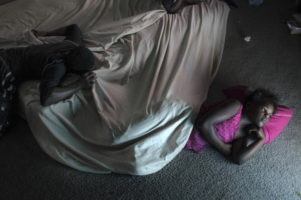

JC: There also is the growing crisis of photography in the news, with, now, “alternative facts” even. How do you think should photographers deal with this?
PvA: This is a real conundrum. The Trump administration’s rejection of the side by side comparison photographs of Trump’s inauguration versus Obama’s was startling. I have a lot of criticisms of the manipulative potential of photography, but that was as close to objective as it gets. For the veracity of the image to be rejected is deeply troubling.
I like Fred Ritchin’s “Four Corners” proposal, which seeks to embed pertinent information in the image file itself, but who knows how widely it will be adopted? People seem to believe what they want to believe these days, and sometimes it’s less about the facts themselves than how they are presented. I read Fox News everyday now as well as the New York Times. The gap in tone and content can be startling. I just came back from a story in Guantanamo Bay and was assigned to share a small house with an IT worker who voted for Trump. We had a series of thoughtful conversations at night, and while our core beliefs remained unchanged, we both remarked how refreshing it was to have had the space for those conversations. There was opportunity for common ground. The country is increasingly divided. Social media and the ease of creating a “news” website has contributed to that enormously, and I think it’s much to our detriment. Selfishly, I sometimes wish the internet had never been invented. Still, it’s here and I’ve been spending some time thinking about how to disseminate future work to reach people outside the narrow worlds of the photography community and the mainstream, more liberal oriented press.
JC: Speaking of one of the way how your work has been disseminated so far, there are the books. In 2009, you published 2nd Tour / Hope I don’t Die (Photolucida), followed by Disco Night Sept. 11 (self published) in 2014, and now there’s Buzzing at the Sill (Kehrer). So even though a lot of your work is assignment-based, the photobook is important for you. But your approach to making them appears to have changed, from the almost classical photojournalistic 2nd Tour to Buzzing, which mixes autobiography with the impact of larger historical forces shaping or created by this country. Would you agree that you’re a vastly changed photobook maker, and if yes what created those changes (if no, how are these books not changed)?
PvA: My first book was created in a bit of a rush, and it was flawed for many reasons. I still like it, and think it represents my thinking at that time quite well, but I’m not sure I was quite ready for it. I owe a big debt of gratitude to Chiho and Christoph Bangert for helping me through it. Still, it was a great learning experience. Disco Night Sept 11 was much more fully formed. I was more confident in being heavily involved in the design and sequencing, and vetted the content and flow through dozens of people before putting it out into the world. It also has its flaws. It’s purposefully a very sober design and structure which omits some of the flashier potential of the photobook, but I remain happy with the outcome. It felt like it came together in an organic way, and when it was finished it had inhabited its proper form. Buzzing at the Sill is quite a different book, but the process was similar. I started with around 700 pictures (taken from 2009-2016), and slowly whittled it down to the core of 72 images in the book. Through the process of making it, I went through a number of wholesale design changes before arriving at the current structure of flat, full bleed double page images. Inevitably that structure has its compromises as well. I wanted the final object to be something intimate while still giving the detail oriented photographs some space to breathe. I assume the next books will be different still as they coalesce into whatever form best suits the work. While the books are different, the core approach hasn’t changed much. I still believe deeply in the interplay between images and words. I’m still trying to explore these manifest forms of where America has been, what it is now, and where it is heading I hope what I learn has some value to people.
